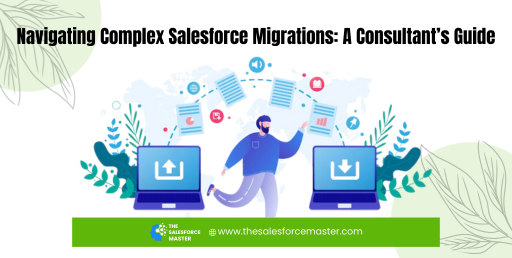
Navigating Complex Salesforce Migrations: A Consultant’s Guide
Migrating to Salesforce can be a daunting task, especially for organizations with complex systems. This guide aims to help consultants manage Salesforce migrations effectively, from planning to execution. We will cover essential steps, key considerations, and best practices to ensure a smooth transition. By following these guidelines, consultants can mitigate risks and ensure a successful Salesforce migration.
1. Developing a Robust Migration Strategy
The first step in any Salesforce migration is to develop a comprehensive strategy. Start by identifying the scope and objectives of the migration. Determine which data, customizations, and processes need to be migrated. Conduct an in-depth assessment of the current system and map out dependencies. This analysis helps in understanding the complexities involved and setting realistic timelines.
To avoid unexpected issues, create a detailed migration plan that includes a phased approach. Segment the migration into smaller, manageable parts to test for potential challenges. Engage key stakeholders early in the planning process. Their insights can help identify critical areas that might need special attention. Utilize tools like Salesforce Login to ensure that all users are set up correctly and have the required access permissions.
2. Ensuring Data Integrity and Quality
Data is the backbone of any Salesforce system, and its integrity is crucial during migration. Begin by conducting a thorough data audit to identify errors, duplicates, and missing information. Cleanse the data before migration to prevent issues in the new system. Salesforce offers various tools, such as Data Loader and Data Import Wizard, to help streamline the data migration process.
Data mapping is another critical step. Ensure that data fields in the source system match those in Salesforce. Use automated tools for mapping to reduce manual errors. It is essential to prioritize sensitive data and ensure that it is encrypted during the transfer. Use Salesforce Login features to verify data access and security levels, ensuring compliance with data protection regulations.
To maintain data quality, perform regular data validation checks throughout the migration process. This approach helps identify discrepancies early and minimizes rework. After completing the migration, conduct a comprehensive data reconciliation to ensure all data is accurately transferred.

3. Managing Change and User Adoption
One of the most significant challenges in a Salesforce migration is managing change and ensuring user adoption. Start by creating a change management plan that outlines the communication strategy, training programs, and support mechanisms. A well-defined plan helps alleviate user concerns and promotes acceptance of the new system.
Training is crucial for successful adoption. Organize workshops and hands-on sessions tailored to different user groups. Encourage users to familiarize themselves with the Salesforce interface, including Salesforce Login and navigation features. Provide continuous support through help desks, webinars, and user guides to ensure a seamless transition.
Feedback loops are vital for improving user experience and addressing issues promptly. Create channels for users to provide feedback and report problems. Act on this feedback to enhance system functionality and usability. Additionally, recognize and reward users who actively participate in the migration process. This approach fosters a positive culture and accelerates adoption rates.
Key Considerations for a Successful Migration
- Prioritize Data Security: Protect sensitive data by encrypting it during migration and using secure access protocols.
- Monitor Performance: Regularly track system performance and resolve any issues quickly.
- Leverage Salesforce Tools: Use built-in Salesforce tools, such as Salesforce Login, for seamless integration and user management.
Conclusion
Navigating complex Salesforce migrations requires a strategic approach, meticulous planning, and a focus on data quality and user adoption. By following these guidelines, consultants can effectively manage the challenges and ensure a successful migration. Remember, every migration is unique, but with careful planning and the right tools, a smooth transition to Salesforce is achievable.



